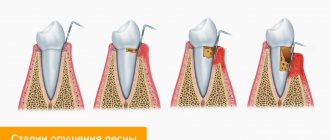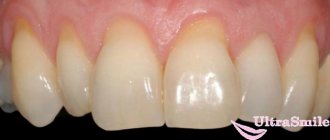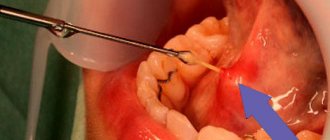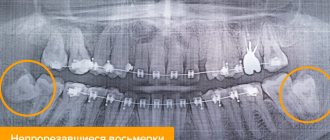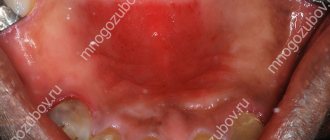If the neck of a tooth is exposed (also called a wedge-shaped defect or recession), you should contact a qualified dentist. In the absence of proper treatment, not only the development of caries and oral diseases can occur, but also the destruction of enamel, increased tooth sensitivity, and inflammation of the gums. At an advanced stage of the problem, the likelihood of exposure of the roots increases, and a person may lose a tooth.
Advantages of treatment of exposed tooth neck at the Academy Dent clinic
During various procedures, Dr. Sadov’s clinic uses modern anesthetic methods. The problem of each patient is carefully studied, qualified doctors prescribe step-by-step treatment, which will use innovative technologies and medications.
Medical instruments are cleaned and sterilized using an autoclave. It is also mandatory to carry out azopyram (checks whether blood remains on the instrument) and phenolphthalein (checks whether alkaline components remain on the instrument) tests.
The clinic’s specialists have extensive experience and regularly attend seminars and conferences to improve their skills (at least 4-6 times every 12 months). Using the latest therapeutic and surgical techniques, doctors prevent tooth decay and reduce the risk of bone and soft tissue diseases.
Why do the necks of the teeth become exposed?
Exposure of the neck of the tooth, the causes and treatment of which are closely related, can cause the patient to have:
- Atrophic gingivitis. Inflammation and swelling of the gums occurs, bleeding occurs, as a result of which the volume of tissue decreases and the neck of the teeth is exposed.
- Periodontitis. In the space between the teeth, the accumulation of pathogenic microorganisms, plaque, and the formation of tartar begins. Next, the soft tissue and ligaments that support the tooth are destroyed. There is a gradual resorption of bone tissue and subsidence of the gums, as a result of which the part of the tooth that should be under the gum is exposed.
- Caries of the cervical zone. When a tooth is damaged by caries, bacteria begin to multiply in the upper part of the crown and the gum tissue is destroyed.
- Improper oral hygiene. Carrying out poor hygiene measures or too intense movements with a toothbrush can cause microtrauma to the gums, the proliferation of bacteria, which results in the development of gum disease, and then the neck of the tooth is exposed.
- Anatomical features of the bite. With crowded teeth, short frenulum or small vestibule of the oral cavity.
- Age-related changes in tissue. This occurs mainly in older people.
- Bruxism. Grinding of teeth and clenching them tightly leads to exposure of the cervix.
- Diseases of the gastrointestinal tract. The altered acidity of saliva, which in most cases is present in gastrointestinal diseases, destroys the enamel. In addition, bacteria begin to multiply in the mouth, pathological processes occur in the soft tissues, as a result of which the neck becomes bare.
Considering the reason why the neck of the tooth is exposed, the disease develops at different rates and different consequences arise.
Symptoms
When the dental neck becomes exposed, it is visible to the naked eye. Especially if the problem concerns the front teeth. The hidden part of the tooth differs from the enamel in yellow. In addition to these signs, you can suspect that the cervix is exposed based on the following symptoms:
- Spicy, sour, cold and hot foods cause pain in all teeth at once.
- Brushing your teeth is an unpleasant experience.
- The gums become swollen, swollen, and inflamed.
- When passing along the gingival margin, the presence of unevenness (steps) is felt.
- The fragility of teeth increases.
- The roots are affected by caries.
- Visual elongation of the tooth, as the edge of the gum has shifted. Visually, it seems that the gap between the teeth has increased.
- The inflammatory process causes the appearance of a periodontal pocket in which pus will accumulate.
- The appearance of a putrid odor in their mouth.
- A weakened tooth is not securely fixed in the gum, increasing the risk of tooth loss.
Surgery
Surgical treatment of dental granuloma may be required only in a few cases:
- obstruction of the root canals - complex, tortuous structure, too thin, narrow canals;
- impossibility of unsealing channels;
- the presence of a pin in the root canal - attempts to remove it may cause injury;
- patient's reluctance to remove the crown.
Many patients prefer granuloma removal because they do not want to resort to long-term treatment and remove a good crown. In this case, an apical resection operation is performed - part of the root is removed along with the granuloma through a small incision in the gums. Less commonly used is hemisection - removal of one root of a multi-rooted tooth along with part of the crown. In this case, further restoration of the crown of the tooth with a prosthesis will be required.
In rare cases, it is not advisable to preserve a tooth with granuloma. For example, if the crown is severely damaged and cannot be restored. In this case, when removing a tooth, the doctor must remove the granuloma from the socket in order to prevent the development of inflammation.
If purulent complications develop against the background of a granuloma, it is important to get help from a doctor immediately. The specialist will provide first aid: relieve acute pain by opening the tooth. Previously sealed canals are opened, and purulent contents are subsequently removed through them. In this case, relief comes instantly.
If severe swelling of the gums or cheeks appears, this may be due to the release of inflammatory contents under the periosteum or oral mucosa. In this case, a small incision is made to drain the pus. Further treatment is possible only after relief of acute symptoms. Drug therapy will also be required - the doctor will prescribe a course of antibiotics. You should not take them on your own. Moreover, it makes no sense to be treated only with antibiotics in the hope that the inflammation will go away - they are not able to eliminate the source of the disease or even reduce it, it is important to take local measures to eliminate the inflammatory process.
The neck of the tooth under the crown is exposed
Crowns must be replaced periodically; they cannot last for decades. A properly made crown extends a short distance under the gum (from 0.5 to 1 millimeter). This seals the tooth, so that nothing from the oral cavity gets under the crown onto the tooth.
Over time, the gum atrophies, that is, it begins to slide off the crown. When the intensity of this process increases, when the gum is exposed by approximately 1-2 millimeters, the tooth is exposed. It begins to get affected by various infections contained in the oral cavity. This is the cause of the development of various diseases, caries, which provoke exposure of the neck of the tooth.
If the tooth under the crown is alive, the person complains of an irritable reaction when eating hot or cold. As the inflammatory process develops, severe aching pain begins to bother you. In such a situation, it is possible to save the tooth root. To do this, remove the crown. There are also treatment methods in which there is no need to remove it. More detailed advice can be obtained from the clinic doctor.
Conservative treatment
For granulomas, conservative treatment is more often used. It consists of mechanical treatment of the root canals. After this, they are filled with temporary healing material - pastes based on calcium hydroxide. After 2-3 weeks, a control image can be taken, and if the inflammation is eliminated, the canals are filled with a permanent material - gutta-percha. A new permanent filling is placed on the crown of the tooth.
There are two treatment tactics depending on the initial condition of the tooth.
1. Treatment of granuloma of a tooth in which the root canals are not filled. In this case, treatment involves the following steps:
- removal of carious tissues, old filling on the crown, if any;
- mechanical treatment of canals - with the help of special tools they expand, the walls are smoothed;
- antiseptic treatment of canals.
Further actions depend on the size of the granuloma. If it is small, up to 3 mm, simultaneous filling is allowed. If the formation is more than 3 mm, then the root canals are filled with temporary paste. It helps the granuloma shrink or disappear completely.
You will have to wear temporary material for no more than 3 weeks. At the end of the period, the doctor will order a repeat x-ray, and if he sees positive dynamics, he will fill the root canals with permanent material. The restoration of the tooth crown is also carried out.
2. Treatment of a tooth in which the root canals have already been filled. In this case, the doctor will first remove the old material. If a tooth has a crown, it must be removed. The root canals must be resealed, and the treatment tactics correspond to those described above: sometimes the installation of a temporary therapeutic filling is required.
The neck of the tooth is exposed, how to treat it
After the doctor has diagnosed the cause of the exposed cervix, he recommends the patient one of the following treatment methods:
- Filling the exposed area. This procedure is indicated at the initial stage of the pathological process. When a wedge-shaped defect has formed, there is nothing to attach the filling material to, so filling is irrelevant.
- Remineralization of enamel. A product containing calcium is used. The patient will not feel pain during the procedure. The process lasts about 10 minutes. A drug is applied to the affected tooth to help strengthen the enamel, protect the roots from exposure, and prevent tooth loss. In addition, the advantage of remineralization is the return of the enamel to its former shine. How many sessions a person needs is determined by the doctor.
- The enamel is coated with fluoride (fluoridation). Special varnishes or gels that contain fluoride are used. Fluoridation can be simple or deep. With the help of such methods, the dental neck is restored and tooth sensitivity is reduced. With deep fluoridation, the drug strengthens the enamel as it penetrates inside it.
- Installation of veneers. This is a thin ceramic plate. It is applied to a previously ground tooth. This technique is indicated for advanced cases. With the help of veneers, it is possible to completely eliminate the disease and minimize the risk of its recurrence.
- Crowns. Before installing crowns, the tooth is ground down. It is a radical way to protect the tooth root and prevent further progression of the pathology.
- Gum plastic surgery.
Drug and surgical treatment
If the cause of exposure of the neck of the tooth is a lesion or pathology of the mucous membrane, the patient is consulted by an implant surgeon. During the operation, tissue taken from the palate of the mouth is implanted under the tooth root. This helps to increase the volume of gum tissue and cover exposed areas of the tooth. At the end of the surgical intervention, sutures are placed on the gums. After this, the patient is scheduled to regularly visit the attending physician, who will monitor the healing process.
Use an antiseptic solution to rinse your mouth. You can eliminate swelling and redness of the gums with the help of medicinal gels. If pus is present, an antibacterial drug is prescribed. The choice of medication is made only by the attending physician; self-medication is prohibited.
Did you know that all dental pathologies can be cured with aligners?
I want to know more about the movement of teeth on aligners
A classification of this pathological process of tooth movement has been created:
- During the first stage,
the teeth move back and forth or, in medical terms, have vestibulo-orally directed mobility. - When, in addition to this, the teeth make movements in lateral directions, the second stage
. - At the most dangerous stage, the third stage
, vertical and circular movements are added to those mentioned earlier. The teeth are already beginning to emerge from the bone alveoli.
If the first two stages are subject to treatment and have a certain chance of recovery, then the last stage of mobility is a kind of sentence - the tooth should be removed.
How to Avoid Gum Recession
In order not to expose the neck of the tooth, it is necessary to lead a healthy lifestyle, maintain proper nutrition, and carry out prophylaxis with a vitamin and mineral complex (with the doctor’s permission). In addition, regular dental care is recommended. This means not only hygiene, but also timely treatment.
If the neck of the tooth is exposed, you need to contact a qualified specialist at Dr. Sadov’s clinic, who will conduct an examination, prescribe an examination, on the basis of which a treatment plan will be drawn up. Self-medication is strictly prohibited. Use traditional methods only after consulting a doctor. Otherwise, the condition may only get worse.
Did you know that all dental pathologies can be cured with aligners?
Star Smile company is a leading Russian manufacturer of aligners.
The design of each set of aligners for patients is based on accurate mathematical modeling of the physiology of patient tooth movement, taking into account the existing pathology. What does it mean? This means that your teeth will be put in place as quickly and comfortably as possible with the help of Star Smile aligners! Star Smile specialists work in more than 70 (!) cities of Russia. We can always advise you in your city for free. And the main thing is to cure it once and for all with the help of aligners!
